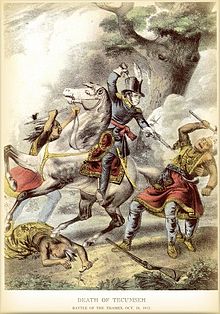Richard mentor Johnson
Richard Mentor Johnson (born October 17, 1780 near Louisville , present-day Kentucky , † November 19, 1850 in Frankfort , Kentucky) was an American politician and from 1837 to 1841 the ninth Vice President of the United States and a member of both chambers of the US Congress .
Early years
Johnson attended local schools in his home country and then Transylvania University in Lexington . After studying law , he was admitted to the bar in 1802. He then started working in his new job at Great Crossings . Between 1804 and 1806, and again in 1819, he was a member of the Kentucky House of Representatives .
Military action

During the British-American War of 1812 he commanded a regiment as a colonel that operated in Canada in 1813. Johnson was injured several times in the Battle of the Thames River . The killing of the Indian chief Tecumseh in a cavalry battle was attributed to him (presumably wrongly) . Johnson was recognized for his bravery, and the incident helped him in his political career.
Political career in Congress
Between 1807 and 1819 he represented his state in the US House of Representatives in Washington . There he was temporarily chairman of the committee that dealt with claims against the state ( Committee on Claims ), as well as a member of a committee that monitored the expenditure of the Ministry of War . After John J. Crittenden's resignation from the office of US Senator, Johnson was appointed as his successor as Class 2 Senator . After a successful re-election he could remain in the Senate between December 10, 1819 and March 3, 1829. In 1828, however, he failed to seek re-election. There was George M. Bibb his successor. In the Senate, he was chairman of the Committee on Post Office and Post Roads . After being voted out of the Senate, Johnson again made it into the US House of Representatives. There he held office between 1829 and 1837. Here, too, he was temporarily chairman of the postal committee and a member of the military committee.
Vice President of the United States
For the presidential election in 1836 he was chosen as a Democratic candidate for the office of US Vice President under Martin Van Buren . Richard Johnson was the only Vice President to be elected by the Senate because he failed to get a majority in Electoral College in the presidential election due to Faithless Electors from Virginia, who voted Van Buren on the electoral college but instead of Johnson William Smith . His relationship with Julia Chinn, a woman with an eighth-part (Octoroon) non-European origin, was criticized.
After the runoff election in the Senate, which he had won against the second most successful candidate for Vice-Presidency Francis Granger with 33 to 16 votes, he took office on March 4, 1837 and was part of the government of the new President Van Buren. His term of office ended in 1841 after he was not nominated for re-election by his party for the 1840 presidential election. However, no other applicant was able to achieve the required two-thirds majority of the delegates at the nomination party congress. Van Buren therefore campaigned without a running mate . It was the only time in American history , apart from George Washington in the first two elections, that a candidate ran for the vice presidency without a candidate. If Van Buren had won the election, the Senate would have had to elect a vice-president, as it did in 1836. However, since the election was lost for the Democrats, this did not happen. Johnson resigned from office on March 4, 1841.
In 1850 Johnson was again in the Kentucky House of Representatives . However, he died on November 19 of the same year in Frankfort and was buried there.
Counties in Kentucky , Missouri and Nebraska are named after him.
literature
- Jules Witcover: The American Vice Presidency: From Irrelevance to Power. Smithsonian Books, Washington, D. C. 2014, ISBN 978-1-5883-4471-7 , pp. 88-95 (= 9. Richard Mentor Johnson of Kentucky ).
Individual evidence
- ↑ Peter Clarke Dooyentate: Origin and traditional history of the Wyandotts and sketches of other Indian tribes of North America, true traditional stories of Tecumseh and his league, in the years 1811 and 1812 . Hunter, Rose & Co., Toronto 1870, p. 113–115 (English, archive.org [accessed February 3, 2017]).
- ↑ Mark O. Hatfield , ed .: " Richard Mentor Johnson , 9th Vice President (1837–1841)", Vice Presidents of the United States, 1789–1993 ( PDF ), Washington, DC: US Government Printing Office, 1997: p 121-131.
- ^ Mills, The Vice-President and the Mulatto , The Huffington Post , April 26, 2007.
- ↑ Charles Curry Aiken, Joseph Nathan Kane: The American Counties: Origins of County Names, Dates of Creation, Area, and Population Data, 1950-2010 . 6th edition. Scarecrow Press, Lanham 2013, ISBN 978-0-8108-8762-6 , p. 156 .
Web links
- Johnson, Richard mentor . In: Encyclopædia Britannica . 11th edition. tape 15 : Italy - Kyshtym . London 1911, p. 463 (English, full text [ Wikisource ]).
- Richard Mentor Johnson in the Biographical Directory of the United States Congress (English)
- Richard Mentor Johnson in the Miller Center of Public Affairs of the University of Virginia (English)
- Richard Mentor Johnson in the database of Find a Grave (English)
| personal data | |
|---|---|
| SURNAME | Johnson, Richard mentor |
| BRIEF DESCRIPTION | American politician |
| DATE OF BIRTH | October 17, 1780 |
| PLACE OF BIRTH | near Louisville , Kentucky |
| DATE OF DEATH | November 19, 1850 |
| Place of death | Frankfort , Kentucky |




